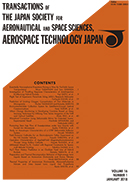Volume 22
Displaying 1-9 of 9 articles from this issue
- |<
- <
- 1
- >
- >|
-
Article type: Full Article
Subject area: Aerospace Propulsion
2024 Volume 22 Pages 1-6
Published: 2024
Released on J-STAGE: January 16, 2024
Download PDF (465K) -
Article type: Full Article
Subject area: Aerodynamics
2024 Volume 22 Pages 7-13
Published: 2024
Released on J-STAGE: January 31, 2024
Download PDF (5693K) -
Article type: Full Article
Subject area: Astrodynamics
2024 Volume 22 Pages 15-24
Published: 2024
Released on J-STAGE: January 31, 2024
Download PDF (2206K) -
Article type: Full Article
Subject area: Aerospace Propulsion
2024 Volume 22 Pages 25-31
Published: 2024
Released on J-STAGE: February 09, 2024
Download PDF (980K) -
Article type: Full Article
Subject area: Structures
2024 Volume 22 Pages 33-40
Published: 2024
Released on J-STAGE: March 01, 2024
Download PDF (3182K) -
Article type: Full Article
Subject area: Aerodynamics
2024 Volume 22 Pages 41-47
Published: 2024
Released on J-STAGE: March 27, 2024
Download PDF (809K) -
Article type: Full Article
Subject area: Aerodynamics
2024 Volume 22 Pages 49-58
Published: 2024
Released on J-STAGE: May 30, 2024
Download PDF (4426K) -
Article type: Full Article
Subject area: Astrodynamics
2024 Volume 22 Pages 59-65
Published: 2024
Released on J-STAGE: May 25, 2024
Download PDF (2303K) -
Article type: Full Article
Subject area: Aerospace Propulsion
2024 Volume 22 Pages 71-77
Published: 2024
Released on J-STAGE: October 11, 2024
Download PDF (785K)
- |<
- <
- 1
- >
- >|
